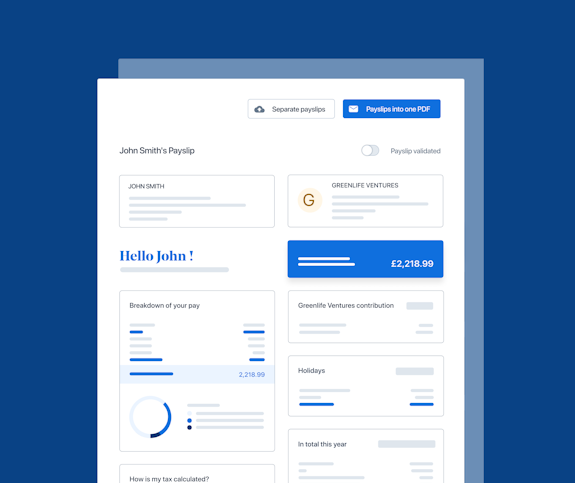- Blog
- |Managing Payroll
- >PAYE and Tax
- >Global Mobility and Tax implications
Global Mobility and Tax implications


In this article, we’ll talk about how global mobility can affect tax and what the options are for employers and employees.
In a recent Global Mobility article, we explained what global mobility means and what employers need to think about before offering this option to their employees. First, employers must establish their employee’s tax residence using the Statutory Residence Test (SRT process).
The SRT will help determine that the employee has one of the following:
Full UK tax liability
Partial UK tax liability
No UK tax liability
What’s next?
Once the employer has established their employee’s tax residence and determined that their tax liability may not sit solely in the UK, it’s important to agree on the correct taxation method with HMRC. Employees will need to let HMRC know that they may have partial UK tax liability, full UK tax liability or no UK tax liability to ensure that:
They are registered to report foreign income where necessary
They avoid double-taxation or are able to claim overpaid tax on foreign income back
It’s better to determine this prior to the employee starting work to minimise tax issues. More information on this can be found on the HMRC website.
So, what are the rules for the different types of tax liability?
The employee has full UK tax liability
& works for a UK entity
Employee may remain on UK payroll and receive net pay through UK payroll
Tax will also be paid through UK payroll
& works for a non-UK entity
The employee may be on UK payroll and receive net pay and tax deductions through UK payroll.
The employee may be on non-UK payroll and receive net pay, but tax calculations must be calculated through a shadow UK payroll.
The employee has no UK tax liability
& works for a UK entity
The employee may remain on UK payroll and receive net pay through UK payroll but tax calculations should be made through a shadow payroll for the country where they have a tax liability.
The employee may move to payroll in the country where they have a tax liability and receive net pay and tax deductions through the host payroll.
The employee has partial UK tax liability
The employee may remain on UK payroll to receive net pay but should have a shadow payroll record in the country where they also have non-tax liability to process tax calculations.
The employee may move to a payroll where their other tax liability is to receive net pay but should have a shadow payroll record in the UK to process their UK tax calculations.
| Term | Meaning |
|---|---|
| Shadow payroll | Payroll is used to make tax calculations but not payments to employees |
| Home payroll | Country payroll in which net pay is paid to the employee |
| Host payroll | Country payroll in which no payment is received but is used for tax calculations |
Depending on the arrangement with HMRC, employers may need to review their payroll processes to be sure they can accommodate an employee with a global tax arrangement.
Often it is at the employer’s discretion how the tax is handled, some employers may want their employees to pay full tax on all earnings in and out of the UK, but often employers put an arrangement in place.
Modified PAYE Scheme
If an employee is seconded to work in the UK, they may be covered by a tax equalisation scheme. Which means:
A fixed net amount is agreed to be paid to the employee
Any tax due above that the employee would pay in their home country is paid by the employer
Not all tax is equal
Different countries have different tax rates (obviously), so what happens if the employee will pay more tax as a result of their change in tax liability?
The employee can take the hit and pay the tax at a higher rate.
The employer can, at their discretion, choose to “equalise” the tax so that the employee only pays tax equal to what they would usually pay so that their net pay does not change.
Why would employers choose to equalise the tax, and how can they do it?
Employers may do this so that the employee is not financially disadvantaged and can smoothly transition into a new working environment.
There are several options available to employers who want to offer a tax equalisation benefit to their employees.
Here, we look at the different schemes that are available for employers to offer to their employees.
Tax equalisation scheme
In this scheme, the employee would pay the amount of tax equal to what they would have paid in their home country. If the host country tax is lower, the employer will retain the difference between the two. If the host country tax is higher, the employer will pay the residual on behalf of the employee.
This scheme requires a pre-emptive tax calculation by the employer.
Tax protection schemes
In this scheme, the employee has a net figure protected and will benefit from paying the lower amount of tax between the home and host country.
This scheme requires a pre-emptive tax calculation by the employer.
Flat rate schemes
In this scheme, the employee will pay tax at an average rate between all tax liabilities taken from all income (i.e. excluding personal allowance). There are no set average rates to use, so companies need to assess an appropriate rate to tax the employee.
This scheme does not require a pre-emptive tax calculation.
What do employers that have employees with more than one tax liability have to consider?
Global mobility is a complex process, made more complicated when we talk about tax equalisation schemes. Before taking on employees requiring a level of global mobility, we would recommend seeking expert help from a tax adviser.
Doing so would help employers in understanding things such as:
Country specific tax rules
What earnings are and are not taxable
Whether it would impact social security (National Insurance contributions)
How to contractually implement a tax equalisation scheme
What do employers need to think about in terms of payroll?
Does their current payroll software or provider allow them to calculate foreign tax?
Does their current payroll software or provider allow them to calculate the correct UK tax?
As mentioned before, global mobility is a complex process, and it has to be looked at on a case by case basis, but when done correctly, it has many benefits such as:
Better time management
Work-life balance
Mental wellbeing
Healthier lifestyle
Employee retention
Remote working is here to stay and comes in different shapes and sizes. We hope that these articles will help employers to understand global mobility better.
Keen to find out more about how PayFit can help with your payroll processes? Book a demo with one of our product specialists today.

PayFit's disclaimer
The information contained in this document is purely informative. It is not a substitute for legal advice from a legal professional.
PayFit does not guarantee the accuracy or completeness of this information and, therefore, cannot be held liable for any damages arising from your reading or use of this information. Remember to check the date of the last update.

A UK 4-Day Working Week - Thoughts On Labour’s Plan

Running payroll - A Guide For New Businesses

The Alabaster Ruling & Maternity Pay - A Guide For Employers

The End Of Zero Hours Contracts? Implications For Businesses

What is the HM Revenue and Customs Starter Checklist

